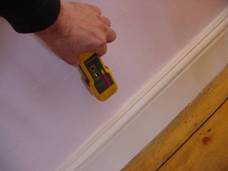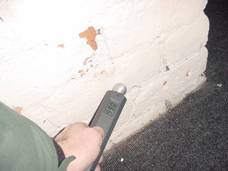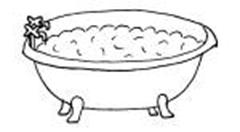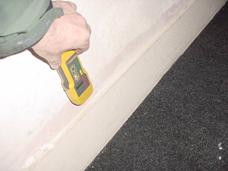Damp Meters
Independent advice on rising damp, lateral damp, condensation or other dampness issues
Our Surveyors carry out residential building reports, structural surveys, specific defects reports, engineers reports, boundary dispute reports, valuations (not for lending purposes), commercial building surveys, property reports, schedules of condition for leases of commercial properties and general property advice.
Please telephone us on Free phone 0800 298 5424 for advice and / or to book a survey report.
Free phone 0800 298 5424
Electronic Damp Meters
Electronic damp meters, or Protometers, as they are generically known, are the main manufacturers.
Damp meters, commonly used by surveyors
 These are commonly used by surveyors; both building surveyors during the course of valuation surveys, or homebuyers reports or building surveys and also damp proof company surveyors. Although we have used the term damp proof company surveyors they are more technically correctly known as damp proof company sales people.
These are commonly used by surveyors; both building surveyors during the course of valuation surveys, or homebuyers reports or building surveys and also damp proof company surveyors. Although we have used the term damp proof company surveyors they are more technically correctly known as damp proof company sales people.
The damp problem that wasn't a damp problem
The reason why the wooden look floor was failing was because of dampness. The flooring contractor pushed the prongs of the damp meter into the floor and got a meter reading of 95% dampness and he advised that the reason why the floor was failing was because of the dampness. However, the customer wasn't convinced and rang us.
A few questions about damp meters
 The customer was originally an electrician and had a few questions, both about dampness and damp meters! The first one being he quite correctly commented that the damp meter wasn't measuring damp it was actually measuring resistance or conductivity, which is quite correct meter measures where the current passes between the two prongs and gives a reading based upon this. We also commented that they weren't electronic either!
The customer was originally an electrician and had a few questions, both about dampness and damp meters! The first one being he quite correctly commented that the damp meter wasn't measuring damp it was actually measuring resistance or conductivity, which is quite correct meter measures where the current passes between the two prongs and gives a reading based upon this. We also commented that they weren't electronic either!
Electronic damp meters are really resistance or conductivity meters
Yes, the secret is out that damp meters aren't measuring damp at all, they are measuring the resistance of electricity between the two prongs and relating this to the amount of moisture that they are scaled to, normally relating to wood.
The convenient problem of dampness
This example of the damp floor, with the flooring company identifying dampness, is just one example of where it is a convenient solution, rather than any thought going into the process. We put, many years ago on this website that damp proof meters were being used frequently by many incorrectly, even though there was much evidence to show, such as articles and information available explaining the problems and also explaining what the damp meters or the conductivity meters can really do. This we duly explained.
The damp proof myth
 We also explained that in Jeff Howell's excellent book The Damp Proof Myth he went to speak to Protim, the main manufacturers in 1994. He in fact spoke to Ernest G. Gobert and Gerald Gobert the founders of Protim and Protometer. They advised that in the 1950's Protim were suppliers of chemicals for the pre-treatment of building timber. They then became involved in the treatment of timbers already in buildings. They could identify a need by experience and a visual inspection. The tool kit comprised of nothing more than a torch and a screwdriver, and we would argue that's all that is needed today; the screwdriver literally being pushed into the timber as hard as possible to see how it resisted.
We also explained that in Jeff Howell's excellent book The Damp Proof Myth he went to speak to Protim, the main manufacturers in 1994. He in fact spoke to Ernest G. Gobert and Gerald Gobert the founders of Protim and Protometer. They advised that in the 1950's Protim were suppliers of chemicals for the pre-treatment of building timber. They then became involved in the treatment of timbers already in buildings. They could identify a need by experience and a visual inspection. The tool kit comprised of nothing more than a torch and a screwdriver, and we would argue that's all that is needed today; the screwdriver literally being pushed into the timber as hard as possible to see how it resisted.
The client was surprised at how basic this was. They decided they needed something more scientific. Gerald Gobert constructed a meter using parts obtained from an RAF suppliers shop and we quote from Jeff Howell's book The Rising Damp Myth. Gerald recalled the owner of the shop referring to the device as the Oxo meter. When asked him what that meant he replied a bullshit meter. It also says he intended to make a few, however, it was noted by a sanitary inspector (we assume that's an environmental health officer today), who considered them to be invaluable in resolving dampness disputes with council tenants. This resulted in other sanitary inspectors requesting them with local authorities. In 1957 Protometer was formed as a separate company to manufacture and sell the meters.
The Rising Damp Myth book by Jeff Howell then goes into great detail on both the Protometers and also the testing that Jeff Howell carried out over many years at South Bank University to try and find rising damp well worth a read.
The dampness problem that wasn't dampness, part two

However, back to our problem: dampness in the timber floor. In this case it was very unlikely to be rising damp as it was on the first floor of the house in the bathroom and rising damp, if it does exist, and we are not sure any more, is generally only considered to rise a metre at the highest, depending upon the materials; bricks or stone or timber frame, and the construction of these materials, location, etc, etc.
What do the damp meter reading s really mean?
s really mean?
What was intriguing the customer was the 95% reading; 95% of what? This is a great question. Companies producing the damp meters are well aware of this and record a percentage moisture content, based on the content of timber, which with a moisture content of 16% or below (by weight) fungal decay does not occur. However, the problem is when this is used in a different material. In this case, you may say well it wasn't used in a different material, it was used in a different floor. That is what the floor appeared to be, it was in fact a modern wood floor, which is a composite material, plus a photo of wood grain, plus the glue that applies it to the floor, plus the flooring it's actually sitting on.
Protometer damp meters are almost useless if used by unskilled people
 As an aside, you can see how this renders the readings almost useless if they are used by a surveyor into plaster, wallpaper, etc, etc, and interesting enough the meters, of course, can be thrown out completely by conductive material. The rather obvious ones, such as oil backed plaster and Clinker blocks and also, we are advised, black ash mortars. There are less obvious things, such as being too close to water pipes (obviously not when using the prongs but using the system where the Protometer is placed against the wall). However, what we think it is in this instance is where a treatment has been used on the timber. Any new timbers use this, including skirting boards.
As an aside, you can see how this renders the readings almost useless if they are used by a surveyor into plaster, wallpaper, etc, etc, and interesting enough the meters, of course, can be thrown out completely by conductive material. The rather obvious ones, such as oil backed plaster and Clinker blocks and also, we are advised, black ash mortars. There are less obvious things, such as being too close to water pipes (obviously not when using the prongs but using the system where the Protometer is placed against the wall). However, what we think it is in this instance is where a treatment has been used on the timber. Any new timbers use this, including skirting boards.
Independent professional advice on dampness from a properly trained surveyor!
If you truly do want an independent expert opinion from a surveyor with regard to rising damp, lateral damp, condensation or other dampness issues as well as surveys, building surveys, structural reports, engineers reports, specific defects reports, structural surveys, homebuyers reports or any other property matters please contact 0800 298 5424 for a surveyor to give you a call back.
Independent professional commercial property advice
If you have a commercial property, be it leasehold or freehold, then you may wish to look at our Dilapidations Website at www.DilapsHelp.com and for Disputes go to our Disputes Help site www.DisputesHelp.com .
Have you discovered something new about damp proof meters?
We hope you found the article of use and if you have any experiences that you feel should be added to this article that would benefit others, or you feel that some of the information that we have put is wrong then please do not hesitate to contact us (we are only human).
The contents of the website are for general information only and is not intended to be relied upon for specific or general decisions. Appropriate independent professional advice should be paid for before making such a decision.
All rights are reserved the contents of the website are not to be reproduced or transmitted in any form in whole or part without the express written permission of www.1stAssociated.co.uk.
Dampness in Buildings - Basics Article
Dampness in Buildings - Technical Article
Resolving Dampness in your Basement
Condensation
Shared Freehold and Problems with Dampness
Dampness Defects Report
Dampness Problems
Rising damp, condensation and damp through your walls
Please see our section on:

